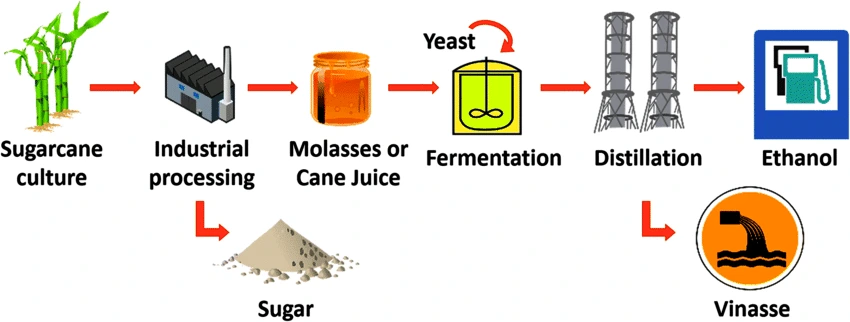Context: The central government banned the use of sugarcane juice and sugar syrup for ethanol production in the 2023-24 supply year to ensure adequate sugar availability and control prices.
Balancing Act: India Takes Steps to Control Food Inflation
- However, the supply of ethanol from existing offers received by OMCs (Oil Marketing Companies) from b-heavy molasses will continue.
- B-heavy molasses is the syrup remaining after the second crystallization process in sugar Production process.
- As per the Indian Sugar Mills Association, sugar production is likely to fall 8 percent to 33.7 million metric tons in the 2023/24 marketing year owing to below-normal rainfall in key growing states.
- In the last sugarcane crushing season 2022-23, the total sugarcane production was 33.1 million metric tonnes.
- The decision to curtail ethanol production is intended to prevent a further decline in sugar inventories in India.
- Other measures taken to control food inflation include banning wheat and broken rice exports and setting MEP for basmati rice.
About Ethanol
- Ethanol is one of the principal biofuels, which is naturally produced by the fermentation of sugars by yeasts or via petrochemical processes such as ethylene hydration.
- Uses:
-
- It has medical applications as an antiseptic and disinfectant.
- It is used as a chemical solvent and in the synthesis of organic compounds
- It is used as an alternative fuel source i.e. Biofuel
Ethanol Production In India:
- In the 2022-23 ESY (December-October) 4.94 billion litres of ethanol produced in the country, a quarter, estimated to be around 1.26 billion litres, came from sugarcane juice or syrup as feedstock,
- while 2.33 billion litres (around 47 per cent) came from B-heavy molasses, and the rest, around 1.3 billion litres, came from grain-based sources.
- In the 2023-24 ESY, some over 2 million tonnes (mt) of sugar could be ploughed back into the total supplies by this order of the government to stop sugar companies from producing ethanol from cane juice and syrup.

| Sugar sector in India:
Regional Production: Uttar Pradesh and Maharashtra, the primary sugarcane-growing states, contribute to approximately 65 percent of the total sugarcane cultivation area.
Key sugarcane-producing states: Uttar Pradesh (225.2 million tonnes), Maharashtra (123.9 million tonnes), Karnataka (62.5 million tonnes), Tamil Nadu (16.9 million tonnes) and Bihar (12.1 million tonnes).
Export share: India stands as the second-largest sugar exporter worldwide.
By Product of Sugar Industry: Bagasse, Molasses and filter muds.
Read more about Sugarcane Production In India here. |
Potential impacts of Ban
- Increased sugar availability and lower prices for domestic consumers.
- Reduced ethanol production.
- The country is looking at 20% ethanol blending by 2025-2026 ethanol year.
- Closure of sugarcane juice and sugar syrup-specific ethanol production facilities.
- Potential job losses in the sugar industry.
Must Read: Global Biofuel Alliance: Advancing Sustainable Energy
Source: Indian Express
![]() 8 Dec 2023
8 Dec 2023

